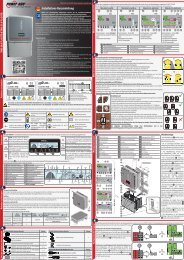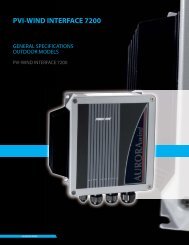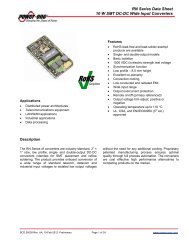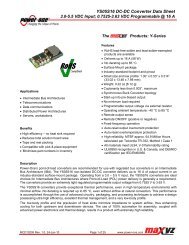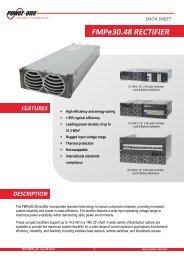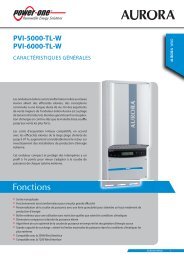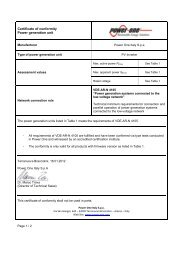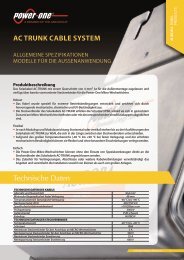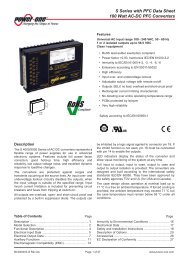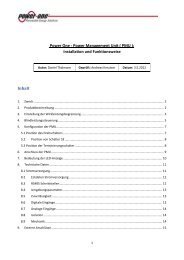Integrated Digital POL Power-Management System ... - Power-One
Integrated Digital POL Power-Management System ... - Power-One
Integrated Digital POL Power-Management System ... - Power-One
You also want an ePaper? Increase the reach of your titles
YUMPU automatically turns print PDFs into web optimized ePapers that Google loves.
^ ^ ^<br />
LEAPFROG: INDUSTRY FIRST<br />
AN ELECTRONIC DESIGN EXCLUSIVE<br />
Roger Allan /// TECHNOLOGY EDITOR<br />
INTEGRATED DIGITAL <strong>POL</strong><br />
POWER-MANAGEMENT SYSTEM<br />
SIMPLIFIES DESIGN, CUTS COSTS<br />
Thanks to an innovative architecture, this system<br />
enables 32 <strong>POL</strong> converters to communicate effectively<br />
under the guidance of a single system controller.<br />
<strong>Power</strong> systems are becoming more complex. To<br />
satisfy different circuit power-supply voltage<br />
and current needs, more and more point-ofload<br />
(<strong>POL</strong>) regulators and dc-dc converters are<br />
crowding pc boards—to the point where<br />
they’re becoming unmanageable. The problem<br />
is threefold: the amount of pc-board space<br />
being absorbed, the number of external components<br />
required, and the lack of coordination<br />
between the horde of <strong>POL</strong> converters.<br />
By investing considerable resources to develop<br />
a digital silicon-based architecture, its Z-<br />
<strong>One</strong> architecture, <strong>Power</strong> <strong>One</strong> came up with a<br />
unique system that fully integrates a power<br />
system’s management functions with those of<br />
the power-conversion circuitry. What results is<br />
a solution that cuts overall system-level costs<br />
by some 20% to 50% compared to existing<br />
approaches and allows an industry-record 32<br />
48 V<br />
<strong>POL</strong> converters to fully communicate with<br />
each other under the command of a single system<br />
controller (Fig. 1).<br />
According to <strong>Power</strong> <strong>One</strong>, this is the most<br />
capable power-management system by far. The<br />
nearest competitor, it claims, offers only 12<br />
<strong>POL</strong> converters with limited functionality and<br />
the need for external tracking field-effect transistors<br />
(FETs).<br />
Central to <strong>Power</strong> <strong>One</strong>’s Z-<strong>One</strong> system shown in Figure 1<br />
is the company’s single-wire Z-<strong>One</strong> digital bus. The highspeed<br />
bidirectional bus provides both frequency synchronization<br />
and data transfer and can access all <strong>POL</strong> converters<br />
in a single communication cycle. It carries all the<br />
information to and from the <strong>POL</strong> converters and the <strong>Power</strong><br />
<strong>Digital</strong> Manager (PDM), including all parameters for<br />
each <strong>POL</strong> converter, such as the output voltage, sequencing,<br />
tracking, monitoring, interleaving, protection thresholds,<br />
feedback loop configuration, and fault-management<br />
information. The digital <strong>POL</strong> converters can operate with<br />
a wide input voltage range from 3 to 13 V.<br />
I 2 C bus<br />
ZIOS graphical<br />
user interface<br />
••• 50 •••<br />
DC-DC front end<br />
Z-series <strong>Power</strong><br />
<strong>Digital</strong> Manager<br />
3 to<br />
13.2 V<br />
Z-<strong>One</strong> digital bus<br />
Host system<br />
Up to 32 Z-<strong>POL</strong>s<br />
1. Up to 32 <strong>POL</strong> converters can be fully programmed and managed from a<br />
single digital <strong>Power</strong> <strong>Digital</strong> Manager using this intelligent Z-<strong>One</strong> series<br />
architecture from <strong>Power</strong> <strong>One</strong>. The architecture integrates control, powerconversion,<br />
and communications functions under one entity.<br />
V OUT<br />
The Z-<strong>One</strong> system integrates two ASICs, the ZM7100<br />
PDM, and the maXyz ZY7000 series of <strong>POL</strong> converters.<br />
Both are based on <strong>Power</strong> <strong>One</strong>’s custom silicon.<br />
The ZM7100 PDM is a centralized system manager<br />
that programs and controls sequencing, tracking, supply<br />
supervision, and intelligence for the analog-to-digital<br />
converters (ADCs) with margining, reset, and environmental-monitoring<br />
capabilities (Fig. 2). The Z-series nonisolated<br />
<strong>POL</strong> converters receive commands from the<br />
ZM7100 PDM that change the settings but also communicate<br />
their status back to the controller. Everything can<br />
be controlled by <strong>Power</strong> <strong>One</strong>’s Z-series Intelligent Operating<br />
<strong>System</strong> (ZIOS), which features a graphical-user inter-<br />
Go To www.elecdesign.com 02.16.04 Electronic Design
●●● INDUSTRY FIRST / <strong>POL</strong> POWER-MANAGEMENT SYSTEM<br />
2. Two ASICs are fundamental to the Z series architecture:<br />
the Z7100 PDM (left) and the ZY7000 series <strong>POL</strong> converter<br />
(right).<br />
face (GUI). Engineers can easily configure<br />
and simulate power architectures<br />
during system design. To add<br />
more flexibility and control to the<br />
system, users can program the<br />
ZM7100 controller through an<br />
industry-standard I 2 C interface.<br />
The ZM7100 can program and<br />
manage up to 32 <strong>POL</strong> converters. It<br />
continuously monitors their output<br />
voltages, currents, and temperatures.<br />
In addition, it monitors the intermediate<br />
bus voltage, accepts external<br />
programmable interrupts, initiates<br />
crowbar protection, and controls dcdc<br />
front ends, including those not<br />
manufactured by <strong>Power</strong> <strong>One</strong>.<br />
In developing this new powermanagement<br />
system, <strong>Power</strong> <strong>One</strong> created<br />
several key pieces of intellectual<br />
property. A significant number of<br />
patents related to the implementa-<br />
tion of the overall system’s architecture,<br />
including control and configuration,<br />
as well as patents in the<br />
design and implementation of the<br />
digital pulse-width-modulated<br />
(PWM) controller have been filed.<br />
The first <strong>POL</strong> converter to be<br />
available is the 20-A ZY7120 with<br />
an input between 3 and 13 V dc and<br />
a programmable output of 0.5 to 5.5<br />
V dc within a tolerance of 1%. The<br />
5-A ZY7105 and the 10-A ZY7110<br />
<strong>POL</strong> converters and ZX7000 series<br />
power blocks are planned series<br />
expansions.<br />
Each <strong>POL</strong> converter features current<br />
sharing and active control of the<br />
low-side FET for turn-on with 100%<br />
pre-biased outputs. The 20-A converters<br />
come in surface-mount packages<br />
for either vertical or horizontal<br />
mounting, with respective dimen-<br />
4. Using <strong>Power</strong> <strong>One</strong>’s ZIOS GUI, various system configurations can be set up on<br />
a host computer display for programming parameters and monitoring the activities<br />
of <strong>POL</strong> converters.<br />
••• 52 •••<br />
3. <strong>Power</strong> <strong>One</strong>’s highly programmable <strong>POL</strong> converters are<br />
available in surface-mount packages for either horizontal or<br />
vertical (shown) mounting.<br />
sions of 1.25 by 0.3 by 0.55 in. and<br />
1.25 by 0.63 by 0.3 in. (Fig. 3).<br />
The converters use digital PWM<br />
control. The 20-A products can handle<br />
current densities of up to 52<br />
A/in. 2 They can also be used as<br />
standalone components without the<br />
ZM7100 controller, via default<br />
tracking, sequencing, and protection<br />
settings, as well as resistor outputvoltage<br />
programming, or a standard<br />
VID code.<br />
GUI PROVIDES FLEXIBILITY • <strong>Power</strong><br />
<strong>One</strong>’s ZIOS GUI, along with its GUI<br />
development tool, provides a comprehensive<br />
set of management and<br />
design capabilities for a power-management<br />
system, including output<br />
tracking and sequencing, <strong>POL</strong>-converter<br />
frequency synchronization and<br />
interleaving, and the setting of<br />
thresholds for overvoltage, undervoltage,<br />
and overcurrent protections.<br />
Four independent OK signal lines are<br />
available for comprehensive fault<br />
management.<br />
Various system configuration windows<br />
can be set up for programming<br />
and viewing a host of power-system<br />
activities. For example, ZY7000<br />
<strong>POL</strong> converters can be set up in<br />
groups to accelerate the programming<br />
process (Fig. 4).<br />
Pricing for the ZM7100 DPM controller<br />
is $12 to $15, and the 20-A<br />
<strong>POL</strong> converter is expected to cost<br />
$16 to $20, in prototype quantities.<br />
Availability is expected in the third<br />
quarter. ED Online 7336<br />
<strong>Power</strong> <strong>One</strong> Corp.<br />
www.power-one.com<br />
(803) 987-8741<br />
Go To www.elecdesign.com 02.16.04 Electronic Design



